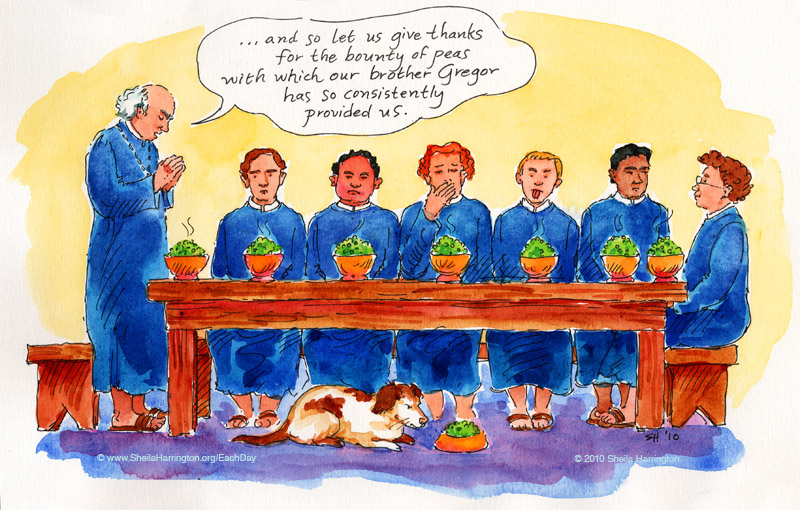When I was in 8th grade, I had a crush on Gregor Mendel. No, he was not a Czechoslovakian exchange student. He was a 19th-century scientist whose birthday it is today. And what red-blooded schoolgirl would not fall for a man who was fascinated with plant and animal heredity and grew thousands of peas to test a hypothesis, thereby becoming the father of modern genetics? (Well, probably there are a few. But it’s a pattern: in third grade my admiring glances fell upon the boy who won all the class math competitions; and my hubby, a man of diverse talents like sculpture, electrical wiring, and the infant football-carry, is also no slouch in the brains department.)
Gregor Johann Mendel (1822-1884) was born into a farming family in the tiny village of Heinzendorf in what was then the Austrian empire and is now the Czech Republic. A bright boy, curious about the many growing things he observed in his rural world, he quickly outgrew the village grammar school. His parents, though not well-off, paid what they could for him to attend school in the next town—which was tuition plus only half his meals, so Gregor often went hungry.
Funding ended abruptly when Mendel was 16 and a back injury prevented his father from farming. Although he always helped with the farm work, Mendel, the only son, was more interested in studying plants and sheep than in raising them. So eventually the farm was sold to provide for living expenses and daughters’ dowries. Mendel took on tutoring work to continue paying for classes and books. And Mendel’s younger sister used her dowry to help her big brother finish high school. Now THAT is a loving sister.
But university education couldn’t be paid for with tutoring. One teacher suggested a solution: if Mendel didn’t mind giving up the possibility of marriage and family, he could enter an abbey. Friars followed a range of paths. They didn’t spend all their time praying and preaching—they were farmers, beekeepers, bakers, teachers, mathematicians, philosophers, scientists. For centuries this had been the road to education for many bright but poor boys (undoubtedly many of them without a genuine vocation).
So Mendel entered the Augustinian Abbey of St. Thomas in Brno, known for its intellectual pursuits and its enormous library, to continue his education. The abbot, recognizing Mendel’s gifts, sent him on to the University of Vienna to study with leading scientists (one of them Christian Doppler, of Doppler effect fame). When he returned, he taught science at the monastery-run high school, for which he apparently had a natural gift, teaching with refreshing clarity and humor. At the same time he continued his own studies in astronomy, meteorology, zoology, and botany.
Interested in the mysteries of heredity since his farming childhood, he wished to investigate its laws. He began breeding mice of different colors to study the pattern of color inheritance, but the bishop thought the study of mouse-breeding was messy and unsuitable for a monk. So Mendel switched to garden peas, which are better-smelling and less shocking in their reproductive habits (although the subject of plant reproduction had certainly shocked the colleagues of Carolus Linnaeus in the previous century).
Mendel received a garden plot in the monastery’s botanical garden and began to experiment with thirty-four varieties of peas: tall, short, yellow, green, wrinkled, smooth, white blossoms, purple blossoms, grey seed, white seed. His goal was to determine what principles governed heredity. Clearly offspring shared some traits with their parents—but which ones, and why? How were characteristics passed from one generation to the next?
TO BE CONTINUED! See July 21st.

